Mandragora 6000
Murad Aleskerov, Ahmed Elgharably, Tohidul Islam, Valeryia Pilchuk
The City College of New York
Our proposed program is the Mandragora 6000, an automated plastic collector modeled after a submarine. It houses several capacitive sensors to detect plastic and activate the built-in vacuums, while also utilizing a compression mechanism to get rid of excess water-weight and compress plastic. The machine’s cylindrical design allows it to remain in an upright position while also allowing it to be easily moved by the ocean’s currents. The Mandragora 6000 will be 15.3 meters in length with a width and height of 6.5 meters and constructed out of titanium alloy. This machine will have a total cost of, excluding labor costs, roughly $13,640 to manufacture. This program was designed by a team of four college students who have taken courses in circuitry, digital design, computer science, and economics.
Introduction
One problem that affects the planet in a broad way is the amount of trash that occupies the oceans and the rate at which it is growing. Although the trash consists of many things, its main component is plastic. Hannah Ritchie, a researcher at the University of Oxford, and Max Roser, an economist working at the University of Oxford, in their article, “Plastic Pollution” (2018) illustrate the large scale effect that plastic has on the environment. They state, “annual production of plastics increased nearly 200-fold to 381 million tonnes in 2015. For context, this is roughly equivalent to the mass of two-thirds of the world population” (Ritchier & Roser, 2018). The plastic not only pollutes the water, but kills hundreds of thousands of marine animals. The trash also leaves the oceans as well as the beaches polluted.
Recently more and more animals have washed up on the beach dead. This isn’t a new problem. In fact, marine life has been affected by plastic ever since plastic became a widely used product accessible by many. Since then, this problem has affected many animals such as sea turtles, whales, birds and more. Many times these animals cannot tell the difference between plastic and food, therefor swallowing a lot of it. Since they cannot digest plastic, it stays in the animals stomach and blocks the way for other food to digest resulting in the death of an animal (“Ocean Plastics Pollution, 2019) . Other than that, plastic such as plastic bags and 6 pack plastic rings can come in an animal’s way, causing them to be stuck and even be strangled to death. Alejandra Borunda, a PhD researcher at Columbia University, in her article, “This pregnant whale died with 50 pounds of plastic in her stomach” (2019) argues that pollution is a global problem because of the harm it’s causing to the environment which she supports with the recent case of the dead pregnant whale. Borunda’s article is just one example of the many animals that die due to plastic.
Other than the atrocious environmental effects, this pollution also has an economic affect. Places that have built their economy on tourism, have to resort to other methods of business as their oceans become too polluted, putting people and businesses out of work. Dr Reese Halter, a recipient of many awards including the President’s Distinguished Service Award from the State University, California, in his article, “The Tourism Crisis: Impacts and Solutions” (2013), discusses the dangers and benefits of tourism crisis. He states: “sustainable tourism can turn poverty areas into thriving economic development zones.” (Halter, 2013). Not only will our invention be saving marine life, but it will also have a positive impact on human life as it can improve the economic standing of many who rely on tourism.
The problem of plastic calls for a solution. Therefore, the purpose of our invention is to decrease the amount of plastic in the oceans. This would not only help save animals, improve businesses and economies, but reduce pollution and clean up our oceans. Our innovation would collect plastic trash, compress it, and afterwards recycle the plastic. The plastic that would be collected would rest on top of the bodies of water. Our innovation would use sensors to distinguish the plastic and seperate it from the other trash. This is estimated to reduce the amount of trash on ocean’s surface by 70-90%. The estimation is backed by previously mentioned Hannah Ritchie and Max Roser, who state that most plastic in the ocean is below 4.75 mm, meaning it is small enough to be easily collected by our innovation (Ritchie & Roser, 2019). With this innovation working successfully, the ocean again become an unharmed piece of nature.
Proposed Program
The machine will be an automated plastic collector. It will be cylindrical, so it can be capable of floating on the ocean surface, carried around by the waves. The floating process will allow the machine to travel to where most of the plastic garbage reside easily. The wave-carried machine also saves energy because the need for manual movement got eliminated. This step will eliminate the cost of moving from the budget. Therefore, the wave carried machine is very useful in locating plastic garbage and saving energy.
This machine is proposed to protect marine life from the danger of plastic garbage, so it is essential to eliminate anything that would harm marine life. Therefore, the wave-carried machine, Mandragora 6000, will have a couple of sensors mounted on the body of the machine. The type of sensor is called a capacitive sensor. According to Sean Miller’s published article on Pepperl+Fuchs Blog, “Capacitive sensors have either a fixed sensitivity or an adjustable sensitivity. Depending on the material of the tube or sidewall, a capacitive can be selected to mount on the exterior of the tank/ tube and detect the fluid through the wall”. Capacitive sensors are intended to detect plastic, wood, and other raw materials including metal. When the sensors detect plastic, a vacuum will turn on. The purpose of this vacuum is to suck the detected plastic from the surface of the water into the vacuum container. Some counter opinions might state the question, “How can the vacuum distinguish between metals and plastic since the purpose is to collect plastic?” The density of metals, which is higher than the density of water, causes metals to sink below the water surface, so plastic is the only material left on the water surface that the vacuums can suck in. The vacuum container is designed to have a waste compactor. Waste compaction is the process of compacting waste, and reducing it in size. Garbage compactors and waste collection vehicles compress waste so that more of it can be stored in the same space. According to SP industries in their Waste Guide, “waste compaction is often beneficial, both for people disposing of waste and the company collecting it. This is because waste collection companies frequently charge by volume or require the use of standard-volume containers, and compaction allows more waste to fit in the same space.” (Waste Compaction). Therefore, the primary purpose of the compactor is to compress the plastic garbage and save space inside the vacuum container for the machine to be able to contain more plastic.
Furthermore, one piece of technology added to Mandragora 6000 is a device that will send an alarm to a communication center that is run by human workers; the alarm indicates that the vacuum container is almost full. At this point, a group of trained workers will find the machine through a GPS device mounted in the machine to track its location and movement. When the machine is found, workers will empty the vacuum container. The collected plastic garbage will go to recycling factories to go through the well-known recycling process.
Mandragora 6000 is a well-designed and innovated machine that will be advantageous in many ways if manufactured and became in use. Plastic material will be collected for recycling; the machine will reduce the amount of plastic garbage floating and save thousands of marine organisms as well.
Description of Innovation
Mandragora 6000 (Second name “The Ghost of Submarine”)
Inspiration – submarine
Size of the robot is 6.5 meters (Width) X 6.5 meters (Height) X 15.3 meters (Length)
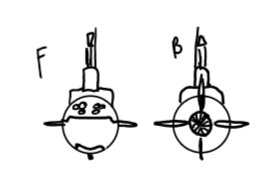


The robot must collect only one type of garbage, plastic. It must also be reliable upon and not sink due to bad weather. Which means that a ship should look like a cylinder because it would be more efficient since it could float from all sides, making it sustainable to bad weather such as mild hurricanes. Furthermore, the robot should contain a motor, sensors, container for plastic, ballast, and more. With further research, we decided that the one existing innovation that fit all of our needs was a submarine.
Our innovation will contain a lot of parts from a standard submarine. A submarine is a watercraft capable of independent operation underwater. It differs from a submersible, which has a more limited underwater capability.
All surface ships, as well as surfaced submarines, are in a positively buoyant condition, weighing less than the volume of water they would displace if fully submerged. To submerge hydrostatically, a ship must have negative buoyancy, either by increasing its own weight or decreasing its displacement of water. To control their displacement, submarines have ballast tanks, which can hold varying amounts of water and air. The robot will be different from a submarine in the way it transports itself around water. The robot will not dive. Because of how it is constructed, the robot will have the appropriate weight to keep itself afloat. As soon as the robot will begin working, it’s ballast will be filled with water. The robot will push out a certain amount of water thereby to fill the container with garbage.
Ballast Tank

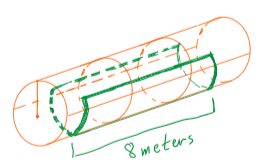

Submarines in a neutral buoyancy condition are not intrinsically trim-stable. To maintain desired trim, submarines use forward and aft trim tanks. Ballet pumps can move water between tanks, changing the weight distribution and directing the nose of the sub up or down for stability on waves.
Hydrodynamic maneuvering is done by several surfaces, which can be moved to create hydrodynamic forces when a submarine moves at sufficient speed. The stern planes (hydroplanes in UK), located near the propeller and normally horizontal, serve the same purpose as the trim tanks, controlling the trim, are commonly used, while other control surfaces may not be present on all submarines. The fairwater planes on the sail and/or bow planes on the main body, both also horizontal, are closer to the center of gravity, and are used to balance control with less effect on the trim.
Navigation

To navigate the innovation, we will use the GPS navigator. According to garmin.com “The Global Positioning System (GPS) is a satellite-based navigation system made up of at least 24 satellites. GPS works in any weather conditions, anywhere in the world, 24 hours a day, with no subscription fees or setup charges.” GPS receivers allow submarines to navigate without human input. When integrated into other techniques, such as laser light, radar, odometry, and computer vision, robotic submarines can automatically sense, store, and retrieve data about the surrounding environment.
Sonar
Active sonar relies on an audible “ping” to generate echoes to reveal objects around the submarine. Active systems are rarely used, as doing so reveals the sub’s presence. Passive sonar is a set of sensitive hydrophones set into the hull or trailed in a towed array, normally trailing several hundred feet behind the sub. Also, sonar can scare animals around it. This is important so that animals do not get stuck in the pumps.
Electrical Motor
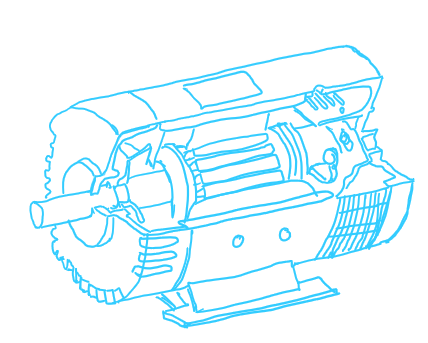
One of the differences of mandragora and submarine will be in the engine. While submarine working on diesel, mandragora will be working on electricity. Mandragora will have electric motor. An electric motor is an electrical machine that converts electrical energy into mechanical energy. Most electric motors operate through the interaction between the motor’s magnetic field and electric current in a wire winding to generate force in the form of rotation of a shaft.
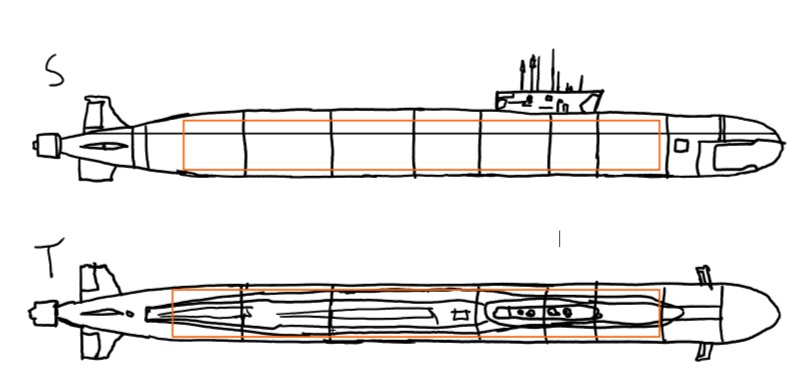
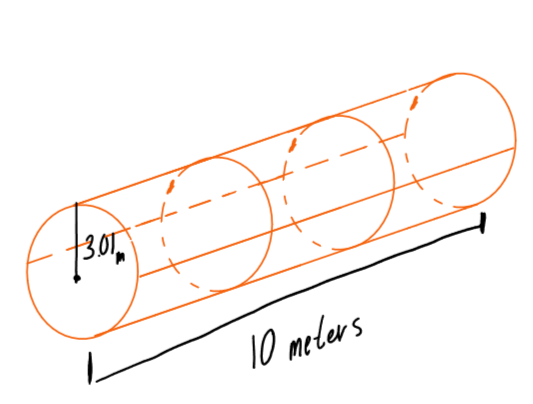
The radius of the container is 3.01 meters X 10 meters (Length)
Vacuum (orange tubes) and water ejection (blue tubes)
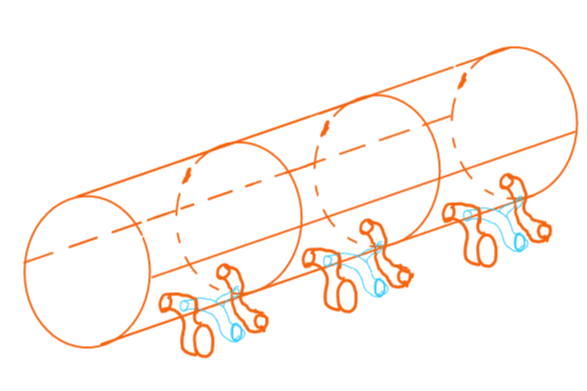
The vacuum (orange) will absorb water and plastic. Also, it would push out the water (blue). The radius of vacuum pump will be 10 cm.
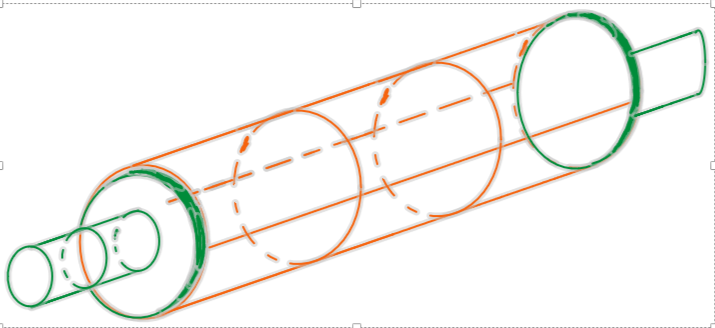
Green will be a compressor for plastic
Cost and Labor
The Mandragora 6000 will be constructed out of titanium alloy due to the metal’s “strength, heat, water, and salt resistance, and its light weight” (“Types of Titanium Alloys”, 2018), which make it well suited to handle the harsh conditions of open water. The specific type of titanium alloy that will be used is Ti 6Al-4V which is more commonly known as grade 5 titanium alloy. This alloy is typically used in military warcrafts and surgical tools which demonstrates the metal’s reliability. Each sheet of thirty-six inches by forty-eight inches grade five titanium alloy will cost one-thousand forty dollars when bought from the titanium processing center. Since the combined surface area of the outer-shell and container of the Mandragora 6000 is seventeen-thousand two-hundred sixty-seven square inches, it will take ten sheets of thirty-six inches by forty-eight inches grade five titanium alloy to cover the entire machine. This equates to a cost of ten-thousand and four-hundred dollars for the metal casing.
The additional costs of the inner components include: twelve capacitive sensors for eight-hundred forty dollars, twelve vacuum pumps for one-thousand eight-hundred dollars, a compressor for three-hundred dollars, a battery for one-hundred dollars, and two-hundred dollars for various miscellaneous parts such as wires, circuit boards, and welding equipment. This creates a total cost of roughly thirteen-thousand six-hundred forty-dollars without including labor costs.
To determine the time it will take to construct our machine we looked at the average construction time for a Virginia-class attack submarine, which is roughly one year according to a congressional research service report (O’Rourke, 2019). Based on this information, we can estimate that the Mandragora 6000 will take less than half that time to complete because it does not require the weaponry or excessive features that a normal submarine has. From this comparison we determined that our machine will take two to three months to build with a team of around thirty construction workers and engineers working eight hours a day.
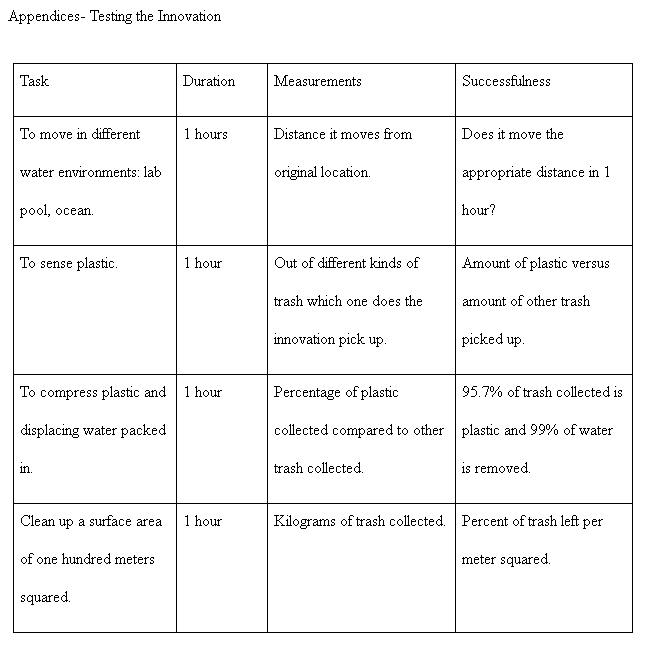
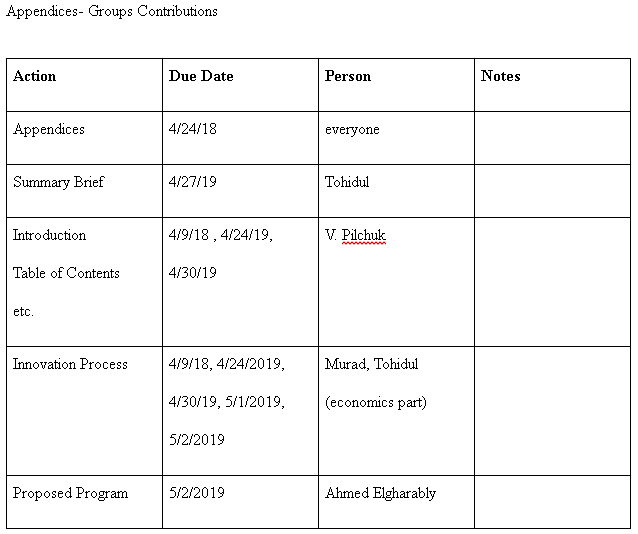
Key Terms:
Buoyancy: the ability or tendency to float in water or air or some other fluid.
Hydrostatic: relating to or denoting the equilibrium of liquids and the pressure exerted by liquid at rest.
Ballast: heavy material, such as gravel, sand, iron, or lead, placed low in a vessel to improve its stability. In our scenario this is a load of water.
Salinity: the saltiness or amount of salt dissolved in a body of water, called saline water
Intrinsically: in an essential or natural way.
Hydrodynamic: a branch of physics that deals with the motion of fluids and the forces acting on solid bodies immersed in fluids and in motion relative to them
Inertial: a tendency to do nothing or to remain unchanged.
Aft Trim Tanks: Submarines use trim or ballast tanks to control both buoyancy and trim of the boat.
Reference
The name came from the book “Harry Potter and the Philosopher’s Stone”, by british author J. K. Rowling in June 26 1997.
Some people believe that mandragora has magical powers. The root and leaves are used to make medicine. People take European mandrake root for treating stomach ulcers, colic, constipation, asthma, hay fever, convulsions, arthritis-like pain (rheumatism), and whooping cough.
Works Cited
(n.d.). Retrieved from https://www.whoi.edu/science/B/people/kamaral/plasticsarticle.html
30 Ocean Pollution Facts That Will Blow Your Mind | Rubicon Blog. (2019, April 23). Retrieved from https://www.rubiconglobal.com/blog-ocean-pollution-facts/
Amaral, K. (n.d.). Plastics in Our Oceans. Retrieved from https://www.whoi.edu/science/B/people/kamaral/plasticsarticle.html
Borunda, A. (2019, April 02). This pregnant whale died with 50 pounds of plastic in her stomach. Retrieved from https://www.nationalgeographic.com/environment/2019/04/ dead-pregnant-whale-plastic-italy/
Dead Pregnant Sperm Whale Washes Ashore in Sardinia with 48 Lbs. of Plastic in Her Stomach. (n.d.). Retrieved from https://people.com/pets/sperm-whale-plastic-stomach- italy/
Death by plastic waste. (2018, August 12). Retrieved from https://theaseanpost.com/article/death-plastic-waste
Fact Sheet: Plastics in the Ocean. (2018, April 05). Retrieved from https://www.earthday.org/2018/04/05/fact-sheet-plastics-in-the-ocean/
GuglielmiJul, G., MervisMay, J., WadmanApr, M., WesselApr, L., MalakoffApr, D., & MlotApr, C. (2017, July 26). In the next 30 years, we’ll make four times more plastic waste than we ever have. Retrieved from https://www.sciencemag.org/news/2017/07/next-30-years-we- ll-make-four-times-more-plastic-waste-we-ever-have
Henn, C. (2019, April 22). These 5 Marine Animals Are Dying Because of Our Plastic Trash … Here’s How We Can Help. Retrieved from https://www.onegreenplanet.org/ animalsandnature/marine-animals-are-dying-because-of-our-plastic-trash/
Miller, S. (n.d.). Selecting the Best Inductive or Capacitive Sensor for Your Application. Retrieved from https://blog.pepperl-fuchs.us/blog/bid/253162/Selecting-the-Best- Inductive-or-Capacitive-Sensor-for-Your-Application
Ocean Plastics Pollution. (n.d.). Retrieved from https://www.biologicaldiversity. org/campaigns/ocean_plastics/
O’Rourke, R. (2019, April 16). Navy Virginia (SSN-774) Class Attack Submarine Procurement:
Background and Issues for Congress. Retrieved from https://crsreports.congress.gov/ product/pdf/RL/RL32418
Plastic Statistics. (2018, November 12). Retrieved from http://oceancrusaders.org/plastic- crusades/plastic-statistics/
Ritchie, H., & Roser, M. (2018, September 01). Plastic Pollution. Retrieved from https://ourworldindata.org/plastic-pollution
Tibbetts, J. H. (2015). Managing Marine Plastic Pollution. Environmental Health Perspectives, 123(4), A90–A93
Types of Titanium Alloys | Titanium Processing Center. (2018, March 29). Retrieved from https://titaniumprocessingcenter.com/the-element-titanium/
Using Artificial Intelligence For Smarter Recycling – GE. (2017, September 12). Retrieved from https://www.ge.com/reports/dumpster-diving-robots-using-ai-smart-recycling/


